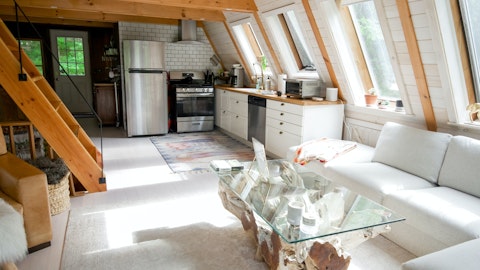Operator: And we’ll move to our next question from Lloyd Walmsley at UBS.
Lloyd Walmsley: My question, you guys have been talking a lot about innovating on the search experience, like working on GenAI, the community side, things like co-hosting. Do you see a path where some of these features over the longer term like community in search drive enough differentiation that you could bring on more traditional supply, things like boutique hotels in such a way that you kind of expand your addressable market and revenue per user while still sort of preserving enough that’s unique about Airbnb? Is that sort of makes sense? Or is that just too far out there?
Brian Chesky: No, Lloyd, that absolutely makes sense. And I think that’s inevitability. Just to back up for a second, we are very much supportive having hotel inventory on Airbnb. And we acquired HotelTonight before the pandemic because we believe so much in it. Over the last few years, we had to make some decisions, especially when our business initially contracted and we made some decisions. We said, well, we have to really just get focused on our core. And our core were individual people renting homes, sharing homes. That is the most differentiated thing. It’s inventory you can’t find anywhere else. It’s a thing that is most defensible, is the thing that attracts all the direct traffic. That being said, I mean, let’s just take New York, for example.
We still have a lot of traffic of people searching for New York and we now have a lot less inventory we used to have so there’s a real opportunity for us to supplement what used to be homes with boutique hotels. They’re already on hotel tonight and others and we can certainly put those in New York. And I generally think for sure, as Airbnb becomes a little more of a so-called like AI travel agent which is what I think all travel apps will trend towards to some extent. I think there’s opportunity for us to do things in a differentiated way even with slightly less differentiated inventory. I think our bread and butter for combinations are always going to be home. I think that’s where our heart and soul is. I also think that’s where the biggest growth opportunity is but you should not think of our total supply — addressable market of supply as only homes.
We’ve had hotels. We’ve just been prioritizing homes because we wanted to be really focused.
Operator: Next, we’ll move to Kenneth Gawrelski at Wells Fargo.
Kenneth Gawrelski: Appreciate it. Two questions, if I may. First, I want to go back to supply. I know you’ve talked a lot about it. The room nights up 19% with double-digit growth in all territories. Yet every week, we read about new STR regulations. At least in North America, could you help us reconcile this kind of this contrast for the financial market? Like what are we missing as investors here — where is that supply growth really happening, especially in the kind of Western markets? And then my second question to be a bit more specific, I know you called out the volatility in room nights and on the demand side in 4Q. Are there any specific regions that you would call out? Or is it more broad-based? And just on the timing standpoint, did this start in October? Or did you see some of the volatility start in 3Q?
Brian Chesky: Maybe I’ll — go for it, Dave.
David Stephenson: Well, I’ll just start with the volatility in room nights. There’s not a specific region where we’re seeing it. I think maybe the biggest thing we’ve seen is that it’s more broad-based on a global basis right now which is why we’ve kind of called out the macroeconomic and potential geopolitical issues as a potential driver to it. We saw maybe some of it just late September and it’s kind of been early October. And again, it’s just a little too early to tell how much volatility we see going into the rest of the quarter. That’s why we continue to highlight the revenue growth that we’re still expecting this year between 12% and 14% and our growth overall. And then on the regulation side, I mean, I think it’s a lot of what Brian said earlier that 80% of our top 200 markets already have regulation.
I think the headlines, they tend to make good headlines when people are highlighting kind of issues with short-term regulation. But in many ways, outside of New York City, I’ve never been — felt better about our overall regulatory landscape on a global basis. We have really good partnerships with many cities around the world and things like our City Portal and other things has made us continue to collaborate extremely well with the vast majority of cities. So, I think those are outliers. But Brian?
Brian Chesky: Yes. Yes. And I’d just say, like, again, we’re in like 100,000 cities around the world and for every headline you read, there’s cities that actually have very workable solutions. There’s not a lot of activity. We’re actually seeing growth in supply across all types of markets, not just big cities where you see in headlines. And I think vacation rental destinations — in fact, there’s a U.S. Census report that we looked at. I think said that 2/3 of markets where Airbnb exist, there aren’t even hotel. So if you just think about that way, there’s a lot of markets where there aren’t even hotels, especially in the vacation rental in the nonurban areas. So the way I’d reconcile it is just to say that like while you read headlines about a few cities, they actually represent a very small percentage of the overall market concentration that we have.
Operator: And we’ll take our next question from Conor Cunningham at Melius Research.
Conor Cunningham: Just on the 2/3 of the hosts that are using the pricing tool today, as you add new supply, you mentioned that ADRs of new supply is at a higher rate but are those people more likely to use the discounting tools that you’ve kind of mentioned after they’ve listed before? And then maybe on the implications for take rate when you move into international markets, you’re tracking towards — over 50% of your rooms are going to be there. Is take rate can eventually just kind of bleed lower as that expands? Just curious on your thinking about that overall.
Brian Chesky: Yes, I can take the first one, Conor. On tools, generally, new host adopt new tools at a higher rate than existing host. And the reason why is like when you sign up, like we have this really great onboarding and you’re immediately presented with all the tools. Now we do have a percentage of our host, maybe like, call it, 1 million hosts that are highly, highly engaged and they’re going to be really engaged on a lot of these tools. But every new host, as far as they’re concerned, every tool is like — is exactly how you’re supposed to use Airbnb, whereas an older host, there’s an adoption where you have to get them on to the new tools and they’re used to hosting a certain way. So we’re generally seeing that new host would probably adopt new tools at a faster rate than existing host.
That being said, the ADR-related new host might also be related to the mix shift. We’re getting a lot of inventory in nonurban areas. They’re larger homes. So there’s a lot of different reasons I can explain that. Dave, I can hand over to you.
David Stephenson: Yes. And can you read the second question again, it was take-rate on international host?
Conor Cunningham: Yes. Just as you expand internationally, is there going to be a natural reduction in take rate overall as that kind of tracks over 50% of your overall rooms at some point?
David Stephenson: No. I mean, actually, I think over time, the way we think about our take rate is that it’s been very stable. We’ve actually made no underlying kind of recent changes to our absolute take rate. And what we want to be able to do is as we add more services and capabilities, that would be the way to further kind of monetize Airbnb. So what have we done things like adding guest travel insurance has been a nice add for kind of incremental monetization. It’s small but it’s growing nicely. And then as Brian said, there as we kind of expand beyond core and add more services for host and guests, that will be the way to kind of increase it.
Brian Chesky: And you could — theoretically, you could argue the inverse which is to say that as the expanded new markets, they might be more interested in new services that we can offer because hosting is newer to them. So as we expand in new markets and as we expand to new host services, we want to make sure that new host and new markets are percent of those opportunities.





